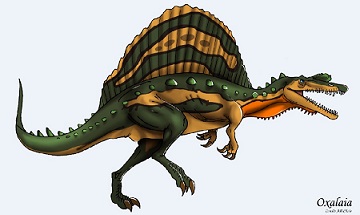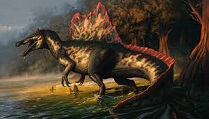
In the annals of prehistoric life, some creatures stand out not only for their size and distinctiveness but also for the mysteries they hold. Oxalaia, a remarkable dinosaur from the Cretaceous period, emerges as one such enigmatic giant. With its imposing presence and aquatic lifestyle, this apex predator has intrigued paleontologists and enthusiasts alike, offering a tantalizing glimpse into the ancient marine realms that once teemed with life.
Oxalaia was first introduced to the scientific world in 1999, following the discovery of partial remains in the Alcântara Formation of Brazil. Named after an Afro-Brazilian deity, the dinosaur's moniker carries a sense of reverence, aptly reflecting its awe-inspiring nature. Oxalaia's discovery opened a window into a world vastly different from today, where colossal marine reptiles ruled the oceans.
| Name: | Oxalaia dinosaurs |
| Size: | Approximately 40 feet long, weight estimated based on size. |
| Main Facts: | Oxalaia was a semi-aquatic theropod predator, adapted for both land and water hunting in the Cretaceous period. |
Oxalaia belongs to the theropod group, a lineage of bipedal, carnivorous dinosaurs. What sets this dinosaur apart is its specialization for a semi-aquatic lifestyle. With adaptations resembling those of modern-day crocodiles and predatory birds, Oxalaia navigated both land and water with equal agility, making it a formidable predator in both realms.

Oxalaia's estimated size places it among the larger theropods of its time. Although exact measurements are challenging due to the incomplete nature of the fossils, it is believed that this dinosaur could have reached lengths of up to 40 feet or more. Its elongated jaws were equipped with sharp teeth, suggesting a diet of fish and other marine prey.
Oxalaia's skeletal features hint at its semi-aquatic habits. Its limb proportions, elongated jaws, and robust build share similarities with modern-day aquatic predators. These adaptations likely facilitated efficient movement and hunting both in water and along coastlines, showcasing the dinosaur's versatility and adaptation to multiple environments.
During the Cretaceous period, vast inland seas and shallow coastal waters dominated many regions. Oxalaia's existence is a testament to the rich marine ecosystems of this era. Its presence highlights the intricate predator-prey relationships that shaped the dynamics of prehistoric oceans, where fierce competition and coexistence played out beneath the waves.
Oxalaia's lifestyle as a semi-aquatic predator likely involved ambushing unsuspecting prey at the water's edge or even pursuing fish through the shallows. Its physical adaptations and behaviors may have allowed it to exploit a variety of food sources, showcasing its ecological flexibility and resourcefulness.
Oxalaia's discovery adds a layer of complexity to our understanding of theropod dinosaurs. It underscores the incredible range of adaptations that this group of dinosaurs evolved, from agile predators on land to semi-aquatic hunters in marine environments. By studying Oxalaia, scientists gain insights into the evolutionary pathways that led to such unique adaptations.
The study of Oxalaia offers a tantalizing glimpse into the intricacies of prehistoric life. It sheds light on the diverse ecosystems that existed millions of years ago, where creatures like Oxalaia thrived in the midst of dynamic environmental changes. As paleontologists continue to piece together its story, Oxalaia remains a symbol of the unending quest to unravel the mysteries of Earth's past, one fossil at a time.
Oxalaia,a Cretaceous theropod dinosaur, captivates with its semi-aquatic lifestyle. With an estimated length of around 40 feet, this predator possessed elongated jaws lined with sharp teeth, indicating a diet likely focused on fish. Its adaptations for both land and water allowed it to navigate diverse environments, showcasing a remarkable ecological niche. Discovered in Brazil, Oxalaia provides a window into the prehistoric world where ancient oceans and coastlines teemed with life.
Its existence underscores the complexity of predator-prey relationships in marine ecosystems, highlighting the adaptability and diversity of dinosaurs. As an enigmatic apex predator, Oxalaia continues to intrigue researchers and enthusiasts alike, offering insights into the dynamic and interconnected nature of Earth's past.
One of the most notable comparisons can be drawn between Oxalaia and Spinosaurus, another iconic semi-aquatic dinosaur. Both dinosaurs shared elongated jaws lined with sharp teeth, suggesting a piscivorous diet. While Spinosaurus was notably larger and inhabited different regions, the parallel evolution of aquatic adaptations in distinct lineages emphasizes the importance of exploiting aquatic resources in prehistoric ecosystems.
Baryonyx, a close relative of Spinosaurus, also exhibited aquatic adaptations and a fish-based diet. Comparisons between Oxalaia and Baryonyx could reveal convergent evolution in different environments and highlight how these dinosaurs navigated semi-aquatic lifestyles in various geographic contexts.
In contrast to typical terrestrial theropods like Tyrannosaurus rex and Allosaurus, Oxalaia's adaptations for aquatic life distinguish it. While the aforementioned predators were adapted for hunting on land, Oxalaia's semi-aquatic nature allowed it to exploit aquatic habitats for food, demonstrating the diverse ways in which dinosaurs adapted to ecological niches.
Comparing Oxalaia to other theropods offers insights into the diversity of ecological roles these predators played. Oxalaia's semi-aquatic lifestyle likely involved ambushing prey near shorelines or pursuing fish in shallow waters, differing from the strategies employed by its land-dwelling counterparts.
Studying Oxalaia alongside its terrestrial and aquatic relatives contributes to our understanding of evolutionary trends and adaptations. Comparisons could reveal common features or anatomical modifications that facilitated survival in specific environments, offering clues about the selective pressures that shaped these dinosaurs over millions of years.
Oxalaia's discovery in Brazil provides an opportunity to compare it with dinosaurs from other regions. By analyzing its adaptations and interactions within the local ecosystem, researchers can draw comparisons and contrasts with dinosaurs from other continents, enriching our understanding of global dinosaur diversity.